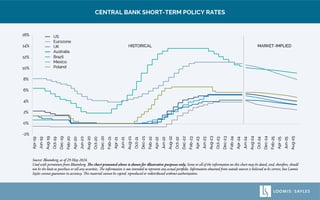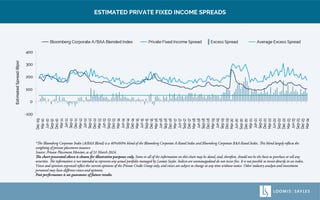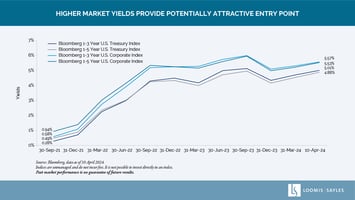
Investment Outlook
The journey toward a downturn phase in the credit cycle is typically more like a brisk walk than a sprint.
We do not see excessive leverage built up in any one major sector of the economy at present. Instead, rapid central bank tightening appears to be putting pressure on all sectors and slowing economic growth broadly. Over the next six months, we anticipate rising unemployment rates in most countries. We believe the resulting loss of consumption due to job losses would catalyze a downturn.
At this juncture, we believe a mild downturn is ahead. However, we do not know how restrictive monetary policy will become or how long tight financial conditions could last. Strong year-to-date performance across assets suggests a soft landing is occurring. In our view, market optimism may be masking what could be ahead.
Key Takeaways
Our take on macro drivers and major asset classes at a glance.

Macro Drivers
We do not expect policymakers to react swiftly at the onset of a downturn while inflation is projected to be above target
in most economies through at least mid-2024.

Corporate Credit
We think corporate credit spreads look very tight for this point in the cycle. However, yield levels, which represent the
cost of borrowing, are very high.

Government Debt & Policy
The Federal Reserve (Fed) delivered tremendous fiscal and monetary support during the GFC and pandemic global
downturns. In our view, it is different this time because inflation, not deflation, has become a threat to longer-term
economic stability.

Currencies
We believe short-term rate differentials should ultimately drive the direction of the US dollar. However, the dollar could also rally in a downturn, even if the Fed becomes less restrictive and other central banks stay tight.

Equities
Valuation expansion, macro headwinds and weakening fundamentals may present a challenging setup for equities.

Potential Risks
A cautious asset allocation stance with a tilt toward fixed income is warranted, in our view, given macroeconomic
headwinds and a corporate profits recession appearing to take hold.
Global corporate profits (measured by the MSCI ACWI Index) will likely continue slipping through year-end. The dip has been shallow in recent quarters, but we believe it will deepen throughout the second half of 2023.
- Monetary policy tightening is already slowing economic activity with borrowing rates for consumers and corporations on the rise. We anticipate more weakness ahead as the full impact of restrictive policy is realized.
- Corporate profit margins should remain under pressure now that pricing power appears to be fading. One positive takeaway, in our view, is less consumer price inflation. A negative is declining profitability.
- We firmly believe that profits drive the credit cycle. And we project that both services and manufacturing industries are likely to experience a material slowdown in demand during the next few quarters.
- As aggregate demand slows and margins continue to shrink, job losses are likely to mount. We think the US unemployment rate is headed toward 4.0% by year-end and most likely higher in 2024.
- We anticipate a similar dynamic to take place in Europe, where some countries, such as Germany, are already in the downturn phase of the credit cycle.
- A loss of jobs typically impacts consumption of goods and services, which is a key growth driver for advanced economies. An additional headwind to economic growth is a decline in corporate capital
expenditures, which we expect while demand is broadly under pressure. - We forecast the peak-to-trough drawdown in US real GDP to be around 0.75%. That would be quite mild relative to the average drawdown of 2.5% for recessions since World War II.
We See a Shallow Decline in Corporate Profits and Layoff Announcements Relative to the Past Three Cycles
If Fed policy remains restrictive well into 2024, then our mild downturn forecast could prove too optimistic.
Sources: S&P Global Q1 2023, Bureau of Labor Statistics 31 May 2023, Loomis Sayles forecast begins
Q2 2023 through Q4 2024.
This material is for informational purposes only and should not be construed as investment advice. Information obtained from outside sources is believed to be correct, but Loomis Sayles cannot guarantee its accuracy.
In this late-cycle environment, yields on corporate credit benchmarks can be a more accurate representation of market risk than spreads.
- In the event of a downturn, we expect spreads to widen out rapidly as systemic risk impacts all credits. We are preparing to deploy capital in markets if dislocations between price and fair value arise.
- Our quantitative and fundamental frameworks suggest that corporate health is set to deteriorate from here. While we believe the direction of travel is clear, the depth of the fallout is not.
- Our risk premium framework, which estimates the potential for positive excess return, suggests credit is likely to outperform US Treasurys over the next six months.1 While odds of positive excess return appear high, they are down compared to six months ago.
- The same quantitative-based risk premium framework currently estimates a high yield default rate of just 2.0%. While expected defaults seem low, estimates have been consistently rising.
- Our survey-based framework, which uses the views of the Loomis Sayles credit research team, indicates that key fundamentals like profit margins, credit outlook and pricing power are likely to remain under pressure for the next six months.
- Loomis Sayles high yield strategists anticipate a default rate closer to 4.0% if a downturn materializes in the US. We have high conviction that spreads will move higher as the downturn approaches.
1 Our risk premium analysis is based on historical data and does not predict future results. Therefore, the use of this type of information to make investment decisions has inherent limitations. There is no guarantee that future experience will be similar. The analysis is limited to certain periods. We make no representation that the experience of any other periods is comparable.
Current Index Yield Levels Look Attractive, Especially With a Muted Default Rate Estimate Relative to Past Cycles
Corporate credit’s yield advantage relative to government bonds could potentially drive positive excess return.
Sources: Refinitiv Datastream, S&P Global, Bloomberg, JP Morgan, as of 21 June 2023.
The chart presented above is shown for illustrative purposes only. Some or all of the information on this chart may be dated, and, therefore, should not be the basis to purchase or sell any securities. The information is not intended to represent any actual portfolio currently managed by Loomis Sayles. Indices are unmanaged and do not incur fees. It is not possible to invest directly in an index.
Past performance is no guarantee of future results.
Market expectations for central bank rate cuts may prove to be overly optimistic.
- Inflation will likely remain a challenging global issue for policymakers during at least the next six months. We believe central bankers will remain resolute in restoring price stability and meeting their targets.
- Some market practitioners have suggested that central bankers could adjust inflation targets modestly higher to accommodate this new macro environment. We do not subscribe to that view. In fact, our own internal measure of global supply-chain bottlenecks has normalized to pre-pandemic levels.
- While our expectations for the downturn phase of the cycle are not overly bearish, we do see risks to the view. Central bank and developed economy balance sheets do not appear to be in a position to haphazardly stimulate.
- If inflation remains well above target, we could see monetary policy in restrictive territory for an extended period—perhaps throughout 2024.
- We believe central banks may tolerate a certain level of rising unemployment if that is what it takes to get inflation back under control and to target.
- Politics can complicate the fiscal side of the equation. However, over the long run, governments typically see price stability as essential.
Inflation Remains Considerably Above Pre-Pandemic Ranges Globally
The pace of central bank tightening is likely to slow, but the hiking phase may not be over.
Source: Refinitiv Datastream, National Sources, Latest monthly data as of 30 June 2023.
This material is for informational purposes only and should not be construed as investment advice. Information obtained from outside sources is believed to be correct, but Loomis Sayles cannot guarantee its accuracy. This material cannot be copied, reproduced or redistributed without authorization.
Downturn phases of the credit cycle are most often associated with the US dollar outperforming foreign currencies.
- There is potential for the European Central Bank (ECB) and Bank of England (BoE) to continue hiking policy rates even if the Fed pauses, because inflation has been a bigger concern for those economies.
- The ECB and BoE are not as far along in their tightening cycles as the Fed, yet inflation is relatively higher in both of those economies.
- We expect the indices used to measure US dollar performance, such as the DXY index, Bloomberg dollar index and the Fed’s trade-weighted dollar index, to continue trading with a firm tone until the Fed makes it clear that the tightening cycle has concluded.
- We expect most foreign currencies to underperform the dollar given our view of the credit cycle and the coming downturn phase. We see potential for select idiosyncratic opportunities, but believe it is hard to beat risk-free rates currently on US-dollar-based Treasurys.
- Emerging market local-currency bonds could be a place to earn carry over high grade US fixed income, and potential strong currency performance. We think select markets could do well, even if the US dollar indices rally.
- Preferred local-currency markets currently include Mexico, Brazil, South Africa and Indonesia. These markets are favored given long-term prospects for consistent structural improvement.
The Fed Appears More Likely to Tighten, or at Least Hold Steady, Compared to the Average Central Bank
The US dollar’s relative “safe haven” status could be beneficial if economic
growth dips and investors turn risk averse.
Source: Bloomberg (chart captures market pricing for 23 different emerging and developed market
central banks relative to the Fed), as of 30 June 2023.
This material is for informational purposes only and should not be construed as investment advice. Information obtained from outside sources is believed to be correct, but Loomis Sayles cannot guarantee its accuracy. This material cannot be copied, reproduced or redistributed without authorization.
Consensus earnings expectations indicate flat global earnings growth in 2023. We anticipate a modest contraction.
- We believe the robust equity market performance during the past six months reflects a highly-optimistic outlook amid what we believe is a very challenging macro environment for companies.
- Corporations appear to be losing pricing power and we expect economic growth to continue slowing. We suspect top-line growth will be tougher to generate and further profit margin compression is likely ahead.
- In our view, MSCI All Country World Index earnings should show an outright decline of nearly 5.0% in 2023. That contraction would be relatively muted compared to past economic downturns.
- The US information technology sector has been a leadership group year to date. We would not be surprised if that continues, even in an equity market correction, given the high-quality nature of those businesses and their balance sheets.
- Overall equity market performance has started to broaden recently to include small-cap companies and less defensive sectors. However, we are reluctant to fully embrace the trend at this late stage of the credit cycle.
- Our stance on equities is similar to that of credit markets: remain invested and be ready to take advantage of potential market dislocations from fair value when volatility returns.
- We currently favor US large caps, information technology and growth style equities. We are cautious on financials overall and emerging markets as a region.
Earnings Estimates Have Been Sliding and There Are Likely More Downward Revisions to Come
In our view, the consensus global earnings rebound of plus 10.0% for next year is very optimistic.
Source: Refinitiv Datastream, IBES, data as of 22 June 2023.
Any opinions or forecasts contained herein reflect the current subjective judgments and assumptions of the Macro Strategies team only, and do not necessarily reflect the views of Loomis, Sayles & Company, L.P. This information is subject to change at any time without notice.
This material is for informational purposes only and should not be construed as investment advice. Information obtained from outside sources is believed to be correct, but Loomis Sayles cannot guarantee its accuracy.
A cautious asset allocation stance with a tilt toward fixed income is warranted in our view given macroeconomic headwinds and a corporate profits recession appearing to take hold.
- Our core view is that the global economy is in a vulnerable position and therefore at risk of entering the downturn phase of the credit cycle. One risk to our base case is if a soft landing scenario actually unfolds, in which case we are currently too bearish.
- Most asset valuations appear to be reflecting a soft landing scenario already. We believe the probability of a soft landing is around 20% and therefore find markets optimistically priced.
- We anticipate a profits recession but there is a risk that corporates find a way to manage through challenges and continue growing earnings despite economic weakness and higher interest rates.
- Inherent in the downturn scenario is a rising unemployment rate. If unemployment does not head toward 4.0% by year-end, then we would not expect a downturn to play out in 2023.
- In the past, the US government has successfully fenced off financial sector woes, but we do not expect that trend to continue. Stimulus out of fiscal authorities would likely come as a shock given inflation issues countries are facing.
- We would be surprised if monetary policy pivots toward rate cuts in the face of a modest recession this year.
- Market performance suggests conditions are quite rosy. We are more cautious.
Asset Class Outlook
We are constructive on duration and neutral on credit. We would look to add growth equity exposure on weakness.
Author
Craig Burelle
Global Macro Strategist, Credit
Disclosure
This marketing communication is provided for informational purposes only and should not be construed as investment advice. Investment decisions should consider the individual circumstances of the particular investor. Any opinions or forecasts contained herein reflect the subjective judgments and assumptions of the authors only and do not necessarily reflect the views of Loomis, Sayles & Company, L.P. Investment recommendations may be inconsistent with these opinions. There is no assurance that developments will transpire as forecasted and actual results will be different. Data and analysis do not represent the actual or expected future performance of any investment product. Information, including that obtained from outside sources, is believed to be correct, but Loomis Sayles cannot guarantee its accuracy. This information is subject to change at any time without notice.
Indices are unmanaged and do not incur fees. It is not possible to invest directly in an index.
Commodity, interest and derivative trading involves substantial risk of loss
Any investment that has the possibility for profits also has the possibility of losses, including the loss of principal.
Diversification does not ensure a profit or guarantee against a loss.
Past performance is no guarantee of future results.
LS Loomis | Sayles is a trademark of Loomis, Sayles & Company, L.P. registered in the US Patent and Trademark Office.
MALR031234


